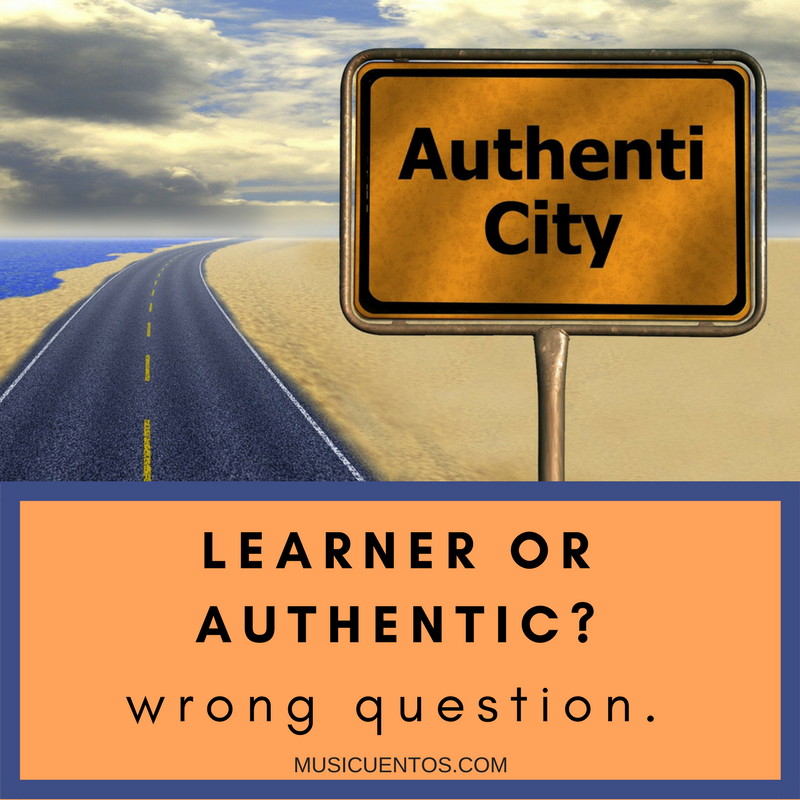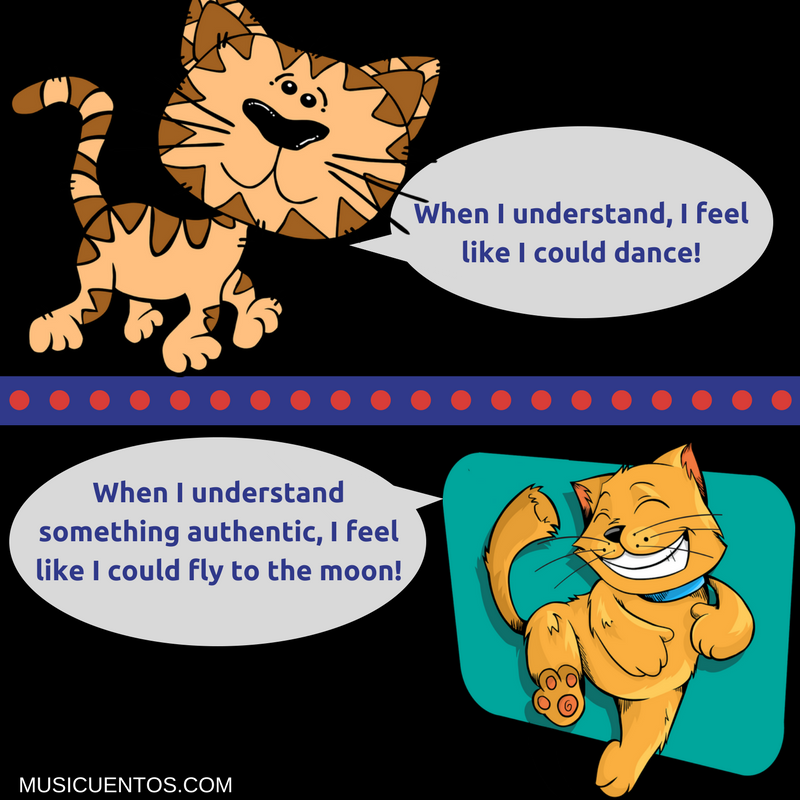Sound off: authentic resources or learner materials?
Uau, that’s a can of worms.
Most teachers I know would say that the answer is a resounding yes. That is, we use both, and we talk about it, a lot. In fact, in the same week (long ago) that I started drafting this post, Carrie Toth blogged a reminder that we should try both.
It could be tempting for us to say,
Of course she said use both– she’s talking about levels 3 and 4. Shouldn’t we keep it all comprehensible in Level 1 and leave the “hard stuff” for the later levels?
In that question, we get to the out-loud, in-our-faces heart of the matter. I suggest we’ve been phrasing this question the wrong way. Again. And again. And again.
During the summer, Laura told us how she got it too: you can pry the infographics from her “cold dead hands” but when she tried to be so “authentic” she had students dragging themselves through resources that “were not appropriate for their level,” you can guess what happened:
Frustration and… no learning, or at least very minimal learning.
Rewind: let’s define some things here.
 When I say “authentic,” I still hold to the traditional meaning of material created by native speakers for native speakers. I understand the viewpoint that perhaps that definition makes our students feel bad that they can’t produce “authentic” language, but that’s not true. It just means they can’t produce an authentic resource for a language teacher’s class.
When I say “authentic,” I still hold to the traditional meaning of material created by native speakers for native speakers. I understand the viewpoint that perhaps that definition makes our students feel bad that they can’t produce “authentic” language, but that’s not true. It just means they can’t produce an authentic resource for a language teacher’s class.
Naturally, learner materials are the other thing: resources produced to help people who are learning the language.
I’m frankly surprised we’re still focused on whether one or the other is inherently better (and that we’re still arguing about whether learner novels are “authentic,” as if they can’t be good unless you can put that label on them). I think the division really comes down to two assumptions, one probably right, and the other probably wrong. And, of course, asking the wrong question.
Acquisition is what it is.
First assumption that presents a bit of a problem: acquisition is what it is. Obviously, that’s true. But when we say that, are we really saying, “We understand now that acquisition is only about comprehensible input, and so the only thing that matters is that it’s comprehensible, in every level.” You might throw the word “engaging” in there or change “comprehensible” to “comprehended” but it’s all essentially the same omniscient declaration.
There are some problems with this. When we’re talking about second language acquisition, researchers are continually talking about how young the field is, how much research hasn’t been done, how much we don’t know about what happens in the learner’s brain. So many questions still exist, such as:
- How can we know if the learning is implicit (unconscious)?
- What can help us with problem of time (there’s not enough of it in a language course)? Can patterning, themes, tasks, feedback make a difference?
- What role does the age of the student play?
- What role does aptitude (some collection of traits that seem to be a natural “gift” for language learning) play?
- Whose definition of comprehensible are we using?
- Does translation matter?
- How can we tell if it was comprehended?
- How much of the input has to be comprehended for meaning to be clear?
If we answer these questions without using words like “generally” and “maybe,” we’re overstating things.
Summary: Acquisition is what it is, but we still don’t quite know what it is, but generally, we know that learners have to assign meaning to input.
Authentic = “hard stuff”
Here’s the second assumption that poses a problem. Often, behind the discussion of whether or not to use authentic resources is the underlying assumption that they are the “hard stuff,” and learner resources are the “easy stuff.” Whatever argument stems from that can go both ways: students need to be challenged by what they’re going to face in the real world, so go for authentic. Or, students will only be engaged by what they can understand, so go for learner resources.
Two things I dislike about this:
1) Often, it disregards proficiency level. There’s no “one is hard/incomprehensible, one is easy/comprehensible.” There’s only “novice learners can comprehend this authentic/learner resource” or “intermediate learners can comprehend this one,” and so on.
2) It means we assume we know how much of a resource a learner needs to comprehend. That’s very much a question that does matter.
Implications: 2 -no, 3- camps
Now, we’ve ended up with basically two three camps arising from this discussion.
- “Only use learner resources because they’re what’s comprehensible, which is the key to acquisition.”
(The second part is probably true. The first part is based on a false assumption: that learner resources are comprehensible and authentic ones are not.) - “Only use authentic resources because that’s what’s in the real world.”
(The second part is mostly true, except a learner is bound to encounter sympathetic speakers who will alter their input, even in the “real world.” The first part disregards any other consideration of the acquisition process, such as that by creating or altering a resource to be more comprehensible to learners, they will improve faster.)
(For more perspectives on this discussion, see Tammy’s discussion on how “the point of using authentic resources is not for learners to be able to understand every word of that resource” and how Chris “learned to avoid #authres.”)
The ubiquitous call for a balanced view
(Here’s the third camp, in case you were wondering.)
At the end of the majority of scholarly research articles, the author will usually call for a “balanced view,” one that lands somewhere in the middle of two previously argued extremes. I’m not doing anything new here by doing the same for authentic resources. Most of the teachers I know land in this camp, the one where if it’s working for us and our students, we use it, and we especially love it when the “it” is authentic because it empowers our students to seize the “I CAN” on something that was intended for native speakers.
Tangentially related, I think this is what’s powerful about PBL, and thus PBLL (see: why reading and writing needs to be authentic): authenticity adds something that inauthentic just doesn’t. In my Russian learning journey, I use authentic resources twice as much as learner resources. When I understand a learner resource, I’m excited, but I shrug my shoulders a bit, because that was the point. When I understand an authentic resource, I feel I could fly to the moon, because this is something I never thought I’d be able to do.
And there’s my balanced view in a nutshell.
So instead of asking,
Authentic material or learner material?
Let’s ask,
Do my learners understand in a way that helps them improve their skills?
In someone else’s better words, authentic or not, it’s all about the Goldilocks corollary.
In my classes this year, we’ll probably end up doing four Fluency Matters novels – certainly materials created for language learners. At the same time, I’ll consistently expose my students to authentic videos, maps, infographics, and texts about the topics, and if I have to, I’ll modify them. Why? Because I tried feeding my learners a steady diet of learner language until they were in an upper-level class, and what I got was a small upper-level class populated by students who had to fight to understand anything that wasn’t in learner speak.
And now that I’ve gone on and on, I’m asking you to do two things.
- If you’re going to be at ACTFL ’17 in Nashville in November, come help me hash this question out in my session “Go ahead, adapt the text!”
- If you’re blogging, Facebooking, commenting, Twittering, Insta-ing or otherwise sharing content online, would you take some time to join #authres August? Share your favorites using the hashtag #AuthresAugust. Authentic resources are very valuable if we’re asking the right questions about them, and I want to see what you’ve found that fit.
What have you found that’s just-right comprehensible?
6 Comments
Comments are closed.






[…] about how I find authentic resources. If you have an authentic resource to share, hop on over to Musicuentos to share yours! Also, if one of my links is incorrect or broken, please let me know, so I can […]
So glad you’re back from your summer hiatus! It has always been about balance for me and you have expressed this well in this post. I will be in your sessions in Nashville. Can’t wait!
[…] Have you taken a side in the longstanding debate on whether to use authentic materials or learner materials in the classroom? See where I stand on the issue in my fifth-most popular post of 2017, “Authentic or Learner Material? Wrong Question.” […]
[…] picks, check out my authres tag. Definitely take a look at my post from last August called “Authentic or learner material? Wrong question.” It’s all about creating an input-rich, communication-rich classroom with a balance […]
[…] I’ll beat the drum of a balanced approach. I blogged it last year: the question is not authentic or learner material, it’s when and why to use one or the other. (You’ll catch my definition of […]
[…] that asking “Authentic or learner material?” as a guide for choosing resources is the wrong question. The real question is […]